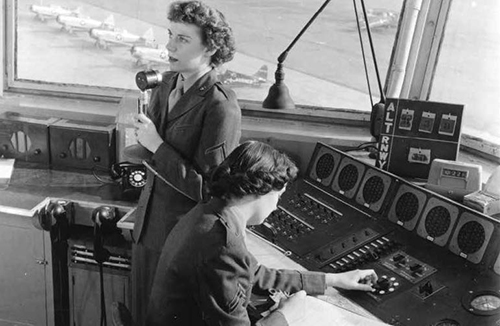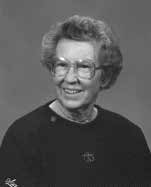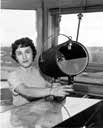
TOWERING WOMEN


February is Black History Month, during which Americans working aviation-related jobs are reminded of the contributions of aircraft mechanics and teachers like Cornelius Coffey and Willa Brown and pilots Besse Coleman and WWII’s Tuskegee Airmen. March is the month to honor women in history. It has been adopted in our industry as Women in Aviation History month.
You might already know of the many aviation records established by America’s famed aviatrix, Amelia Earhart, during the 1920s and 1930s. You might also know that the first woman to solo across the Atlantic Ocean (east to west) was Beryl Markham, flying a Perceval Vega Gull in 1936. The first woman to fly faster than the speed of sound was Jacqueline Cochran in 1953, at the controls of a North American F-86 Sabre. The first woman to solo around the world was Sheila Scott, who departed from England in 1966 in a Piper Commanche. You might also recognize Phoebe Omlie and Ruth Nichols as America’s first and second female licensed aircraft mechanics in 1927.
My research has focused on pilots and mechanics in early aviation, but I wondered, “Who was the first American female air traffic controller?”
Flags and a Lunch Box
With few aircraft in the air between 1903 and WWI, there was no need for controlling a landing field except during air meets or races. In the late 1920s, aviation boomed with more men and women flying and more municipal airports built to accommodate them. The airport control tower, as we now know it, evolved with the advent of ground-to-air radio communications. Commercial flights such as those Transcontinental Air Transport (TAT) offered in 1929 and1930 required improved airport operations.
There must have been some women at work directing air traffic during the 1920s and 1930s, but I haven’t been able to identify them. However, the FAA claims Archie William League (1907-1986) as their first male air traffic controller (ATC). Already a licensed pilot and aircraft mechanic in 1929, League was hired to direct traffic at the field in St. Louis, which is now St. Louis International Airport. With colored flags, League signaled to aircraft when it was safe to take off or land. He hauled his flags, chair, lunch box, notebooks and a shade umbrella to the end of the field in a wheelbarrow. During the winter, League bundled up in his flying suit.
When the airport acquired radio communication equipment in the 1930s, League became the airport’s first radio controller. Thereafter, League excelled in his 36-year career helping to develop the Federal Air Traffic Control System.
Military and Civilian Female ATCs
America’s ATC system went into operation during 1936, but there are no records of female air traffic controllers. Between 1942 and 1943, the U.S. Navy women accepted for volunteer emergency service (WAVES) stepped in to replace male ATCs who had left to join the military. Civilian female ATCs quickly followed. Although official records are incomplete, Billie Gallagher, Martha Olson, Marcelline Price and Carolyn Lorenz are among those known to have eventually worked in the control tower and center at St. Louis. In addition, there are photographs and memorabilia of early female ATCs donated from private collections, as well as information from the National Air Traffic Controllers Association (NATCA,) the Ninety-Nines organization and various military veterans research projects.
 Mary Chance VanScyoc
Mary Chance VanScyoc
According to the historian for the NATCA, Mary Chance VanScyoc began work at the Denver Airway Traffic Control Center in Colorado in 1942. VanScyoc was a licensed pilot, then a requirement of the job.
“Our instrument panel included an anemometer, barometer, a few phones, switches for runway lights and a microphone. All transmissions from the airplanes were audible in the tower. We had no radar and no instrument landing system,” wrote VanScyoc of her job during 1944. From Denver, VanScyoc went to work at Wichita, KA, where the airport was surrounded by factories building military aircraft, including drones, bombers and gliders. These kept the field in constant use for test flights and deliveries. Following her career in the towers, VanScyoc continued to fly and teach school, often volunteering her time at the Kansas Aviation Museum.
 Marian McKenna (Russell)
Marian McKenna (Russell)
Marian McKenna’s family relates that she worked as a civilian employee in towers at Denver; Cheyenne, WY; and Wichita between 1942 and 1949. McKenna married a fellow ATC (becoming Marian Russell) with whom she had worked at all of these locations. In 1963, McKenna attended the NATCA meeting in Nashville, TN. During the festivities, McKenna, VanScyoc and Madelyn Brown Pert were honored as the CAA’s first civilian female ATCs.
Elizabeth Mele
 Elizabeth Mele earned her pilot’s license in 1943 and enlisted in the Women’s Army Air Corps (WAAC), working in the control tower at Bergstrom Field in Austin, TX. Mele attempted to join the Womens Air Service Pilots (WASP) but did not meet the physical height requirements. She immediately enrolled in the air traffic school in Chicago, beginning a career that spanned decades. Mele was among the first women certified by the newly-formed FAA. She retired in 1990.
Elizabeth Mele earned her pilot’s license in 1943 and enlisted in the Women’s Army Air Corps (WAAC), working in the control tower at Bergstrom Field in Austin, TX. Mele attempted to join the Womens Air Service Pilots (WASP) but did not meet the physical height requirements. She immediately enrolled in the air traffic school in Chicago, beginning a career that spanned decades. Mele was among the first women certified by the newly-formed FAA. She retired in 1990.
Marilyn Roberts (Earp)
A military veterans research project for the University of North Carolina reveals one of the first WAVES, Marilyn Roberts, who began in 1944 working as an ATC. Roberts was raised in Michigan where she and two sisters earned their pilot’s licenses. Roberts joined the Civil Air Patrol, then went on to basic training for the WAVES in New York, followed by ATC training in Atlanta. Before her discharge from the Navy in 1949, she met and married ATC Roger Earp while assigned to her ATC job in Illinois.
Women Were There
Following the war, many women were again replaced by their male counterparts but some continued with their career during the transformation from the CAA to the FAA, which now designates various grades within its GS-2152 position for air traffic controllers.
In 1979, Jacqueline Smith (Burdette) and Sue Mosert (Townsend) formed the Professional Women Controllers (PWC) organization which is now part of the NATCA. The NATCA now records that 15 percent of all ATCs in the U.S. are women.
Giacinta Bradley Koontz is an aviation historian, magazine columnist and author who has received the DAR History Medal and honorable mention from the New York Book Festival. She has appeared on the History Channel and in PBS documentaries. For more information, visit www.GiaBKoontz.com.
